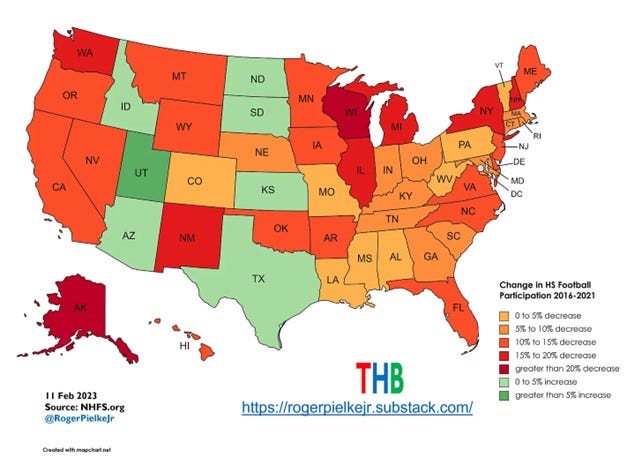American Football remains King of US Sports - as Super Bowl excitement grows
NFL and college football's popularity is rising again - but data for participation levels is less clearcut
Before the COVID-19 pandemic, I documented some interesting trends related to gridiron football in the United States. Across a number of metrics, the ‘king of sports’ was in decline. Youth and high school participation, college spectator attendance, even Super Bowl TV viewership – all down.
I suggested that these trends might have been, in part, the result of concerns over concussions motivated by the death of Junior Seau and the 2015 film starring Will Smith titled Concussion. The trends also indicated an increasing regional focus for football – particularly in the US southeast and Texas.

What is the state of football in 2024, now that we are more than four years removed from the emergence of COVID-19?
The data is mixed, but far more positive for football than five years ago. Let’s start with good news for football. NFL and college football are more popular than ever. In 2023, the Wall Street Journal reports, 93 of the most watched television shows in the US were NFL games. The NFC and AFC conference championships saw the largest audiences in a decade, with over 50 million viewers for each game.
In the highest division of college football, 97 of 133 schools saw spectator attendance increase in 2023 over 2022. The 43 post-season bowl games saw excellent TV ratings, even though almost all games were exhibitions and some notable players chose not to play.
Participation numbers tell a different story. At the high school level there has been a post-pandemic rebound in overall participation, as you can see in the figure below. High-school participation increased from 2021 to 2022 (the most recent year for which data is available) in 39 of 50 US states. But several traditional football hotspots saw continuing declines – including Pennsylvania and Florida.

Even with the one-year increase, overall high-school football participation is about the same as it was several decades ago. The increase from 2021 to 2022 may not signify continuing increases, as youth participation has plummeted. The Aspen Institute's Project Play reports that from 2016 to 2021 tackle-football participation dropped by 29% among children aged six to 12. This cohort represents high school students through 2028, and suggests that the pipeline of participants at the high school level may decrease again in coming years.
A recent, excellent analysis by Dave Sheinin and Emily Giambalvo of The Washington Post suggests an emerging partisan divide on football participation, with conservatives far more likely to recommend youth football than liberals. Most of the change, as you can see in the figure below, is among liberals – 63% recommended youth football in 2012, but only 43% would do so in 2023.
One of the more interesting (and quite odd) dynamics in public discussion of football today is the relationship between pop superstar Taylor Swift and the Kansas City Chiefs player Travis Kelce. Their relationship has become a political flashpoint, with some Republicans taking deep offence (perhaps due to Swift’s get-out-to-vote advocacy). In 2024 USA, anything and everything can become politicised along partisan lines. The Swift-Kelce romance and political overlay may lead to record-breaking viewership of the Super Bowl on Sunday.
Even with the trends in youth and high school participation, the prospects for college football and the NFL are brighter than ever. There are more than a million high school boys playing football, or an average of ~240,000 per class (assuming four years in high school). Across NCAA divisions there are more than 70,000 men who play football, or about 14,000 per class (assuming five years). In the highest NCAA division there are more than 10,000 players, or about 2,000 per class. So there remains a very large pool of high school players from which to populate college teams, especially the top teams, which need only about 1% of graduating high school senior football players to fill out their incoming rosters.
The NFL has even fewer players – 1,696 in 2023, of which about 90% come from college football’s highest division. There remains a well-stocked pipeline of future players to sustain both college and the NFL.
Football is changing, especially at the youth level. What that may mean for participation, attendance and viewership in years to come remains uncertain. However, football’s stature as the king of American sports remains secure for a while.








What brought popularity in viewership back is the vast availability of sports betting. After the 2020 riots, BLM, messages all over the fields and helmets, "black" national anthem, breaking out availability of sports betting has proven to be the savior of pro and college football.
Fascinating. and surprised. I thought the trend was toward soccer because it was safer for kids. We sent you our cutest player* and our best player and you've done nothing with them.
* David Beckham who is definitely cuter than Taylor Swift. Surprised to read recently that Beckham was the bling boy of the 'class of 92'. He loved showing off what he had bought. Alex Ferguson said he ruined his career. He thought his wife controlled him. Maybe she didn't.